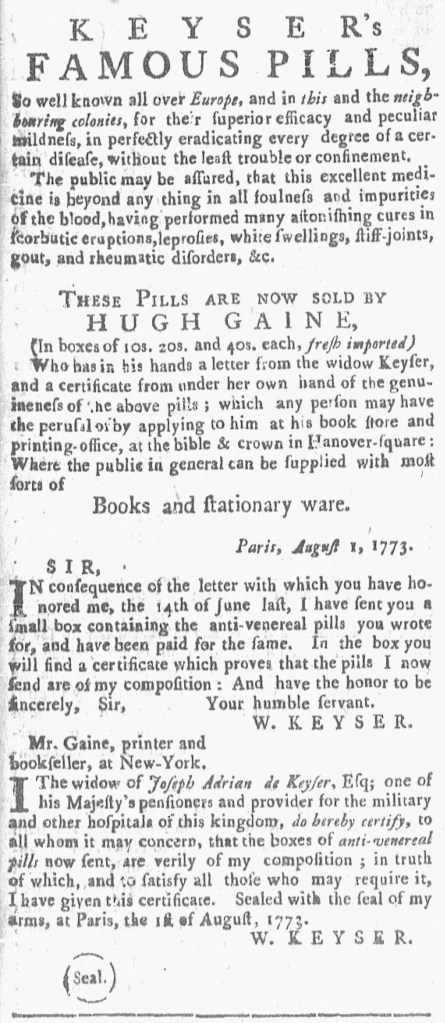What was advertised in a colonial American newspaper 250 years ago today?

“THESE PILLS ARE NOW SOLD BY HUGH GAINE.”
Colonial printers often supplemented the revenues they generated from subscriptions, advertising, and job printing by selling books, stationery, blanks, … and patent medicines. Hugh Gaine, the printer of the New-York Gazette and Weekly Mercury, and James Rivington, the printer of Rivington’s New-York Gazetteer, competed with each other and with apothecaries to sell “KEYSER’s FAMOUS PILLS,” a cure for syphilis and other maladies, in the fall of 1773. Rivington also supplied William Bradford and Thomas Bradford, the printers of the Pennsylvania Journal, with pills that he imported. As he perused newspapers printed in Philadelphia, Rivington noticed that Townsend Speakman and Christopher Carter, chemists and druggists in that city, advertised that they sold Keyser’s Pills acquired directly from James Cowper, “Doctor of Physick” and “the only legal proprietor” of that medicine in England. Rivington sent the Bradfords a letter testifying that he received the pills he forwarded to them directly from the son of the late Keyser, residing in Paris. The Bradfords promptly published that letter in an advertisement that ran immediately below the one placed by Speakman and Carter.
Rivington was not alone in his efforts to gain as much of the market beyond New York as he could. Gaine looked to the north, advertising in the Newport Mercury. His notice appeared at the top of the first column on the first page of the November 29 edition of that newspaper, a place of prominence that likely garnered some attention. A headline in a larger font than anything else on the page except the title of the newspaper in the masthead also enhanced the visibility of the product that Gaine peddled. This advertisement replicated the copy of Gaine’s notice in the New-York Gazette and Weekly Mercury a week earlier, though it did not retain the format. Gaine’s advertisement in the Newport Mercury lacked a decorative border and the multiple manicules that pointed to each letter in “KEYSER,” though it still featured a representation of a “Seal” at the end of the transcription of the certificate of authenticity sent to Gaine by Keyser’s widow. Gaine did not list Solomon Southwick, the printer of the Newport Mercury, or any other associates in Newport as local agents who sold Keyser’s Pills on his behalf. He apparently expected that readers would submit orders to him in New York, an eighteenth-century version of mail order medications.
